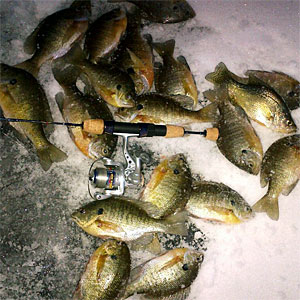

By Joe Devera on Nov 25, 2013 with Comments 0

A nice catch of bluegills using these ice fishing techniques
As the temperature drops and the first snow flurries fall, puddles start to freeze overnight and my mind like, so many others across the ice belt, is focused on ice fishing. Specifically, for bluegill. Generally easy to catch and found in practically every lake, the bluegill is one of the most sought after fish by ice anglers all over the country, typically biting well all year and being pound for pound (ounce for ounce) one of the best fighting fish.
Landing a large bluegill – a true one pounder – is every anglers dream. The most productive areas being the shallows, and cover – weeds, brush, or sunken logs – tends to increase productivity. Having the lakes of the Irish Hills Michigan in my backyard, I have access to some of the best pan-fishing in the country, which has allowed me to learn and adapt to constant changing conditions. I will generally start in five to ten feet of water over a weed bed, I’ll drill a few holes and drop my camera down to see if there’s fish in the area.
When I find them, I’ll drop a size 12 or 14 tungsten jig tipped with maggots or wax worms. When the fish are really active, I’ll switch from live bait to plastics. Starting with dark natural color (usually start with black) in clear water, and bright colors (usually a glow spot) in dirty or stained water, and I’ll make my adjustments from there.
Entering the world of competitive ice fishing, the bite is going to get tough, and I’m going to need the best tackle available. Stopper Lures has a wide variety of lures and colors allows the angler to make the quick changes to stay ahead of the competition and on top of the fish.
My personal favorites are the line of Skandia Tungsten Jigs. Made of heavy tungsten, they sink fast and get you back into the strike zone fast. During the middle winter months, and on small lakes that receive a lot of fishing pressure, or in tournament fishing situations that see a lot of anglers, you may want to go small, a size 16 will do in a pinch. Once you find where the fish are, experiment with size and color until you find what they want.
Be sure to stay mobile. In my experience, when you open a new hole, the most aggressive and usually the biggest fish are the first to bite. Then the hole slows down or the size of the fish greatly decreases. Move around, the fish will hold in the same general area for a period of time. Doing this you will find your bucket filling up and quite heavy by the end of the day.
I wish everyone the best of luck this coming season and tight lines to all.
Until next time friends…
Filed Under: Ice Fishing Tips • Panfish
About the Author: